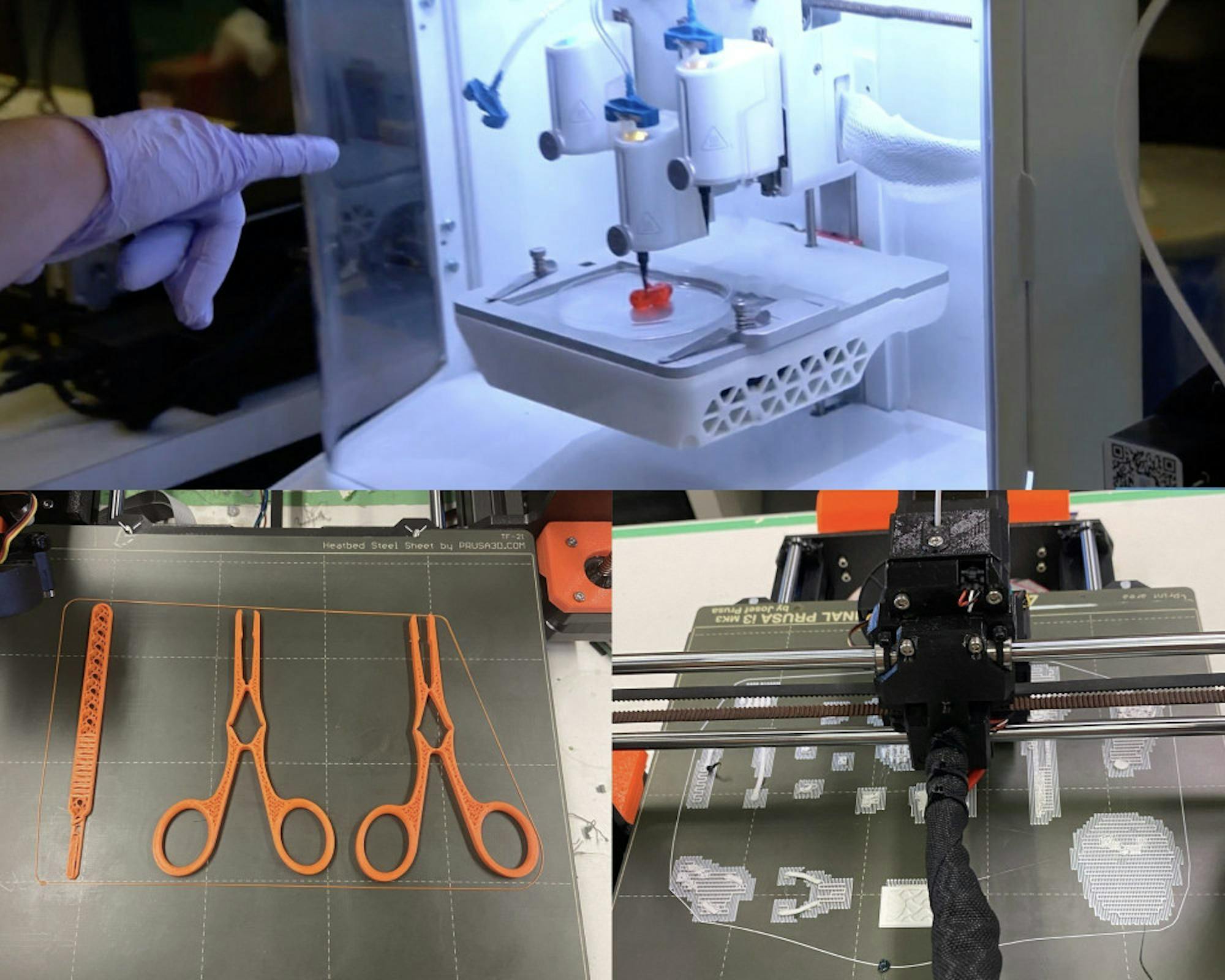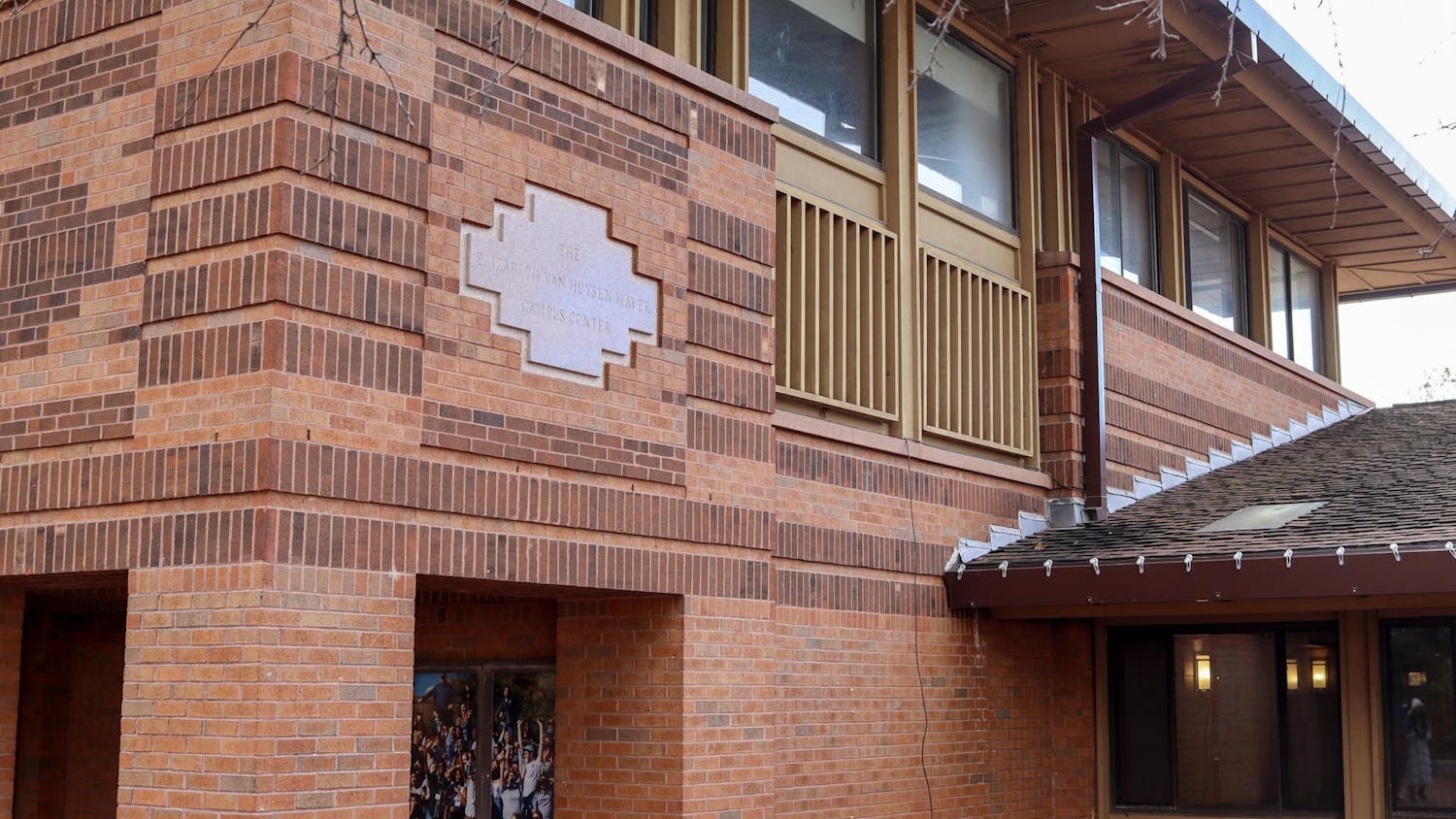Among the 3D printers throughout the room, Vincent Fitzpatrick, a postdoctoral biomedical researcher at Tufts University, holds up a gray unassuming piece of plastic, crisscrossed with a cage-like structure. Hidden beneath a series of support structures that have yet to be removed, he explains, lies a perfect replica of a patient’s bone — assembled from data isolated from a CT scan so that it would have a Cinderella-like fit if surgically implanted.
This is just one of the many models throughout the room that students in 3D Printing the Human Body — a new course in the biomedical engineering department — have created, and it represents just one way 3D printing has revolutionized and continues to redefine modern medicine.
Fitzpatrick decided to teach the class when he noticed the lack of classes available for students interested in 3D printing.
“The idea of the class is to cover as wide a range as possible of new technologies and applications of 3D printing in the medical field,” Fitzpatrick said.
What makes the course unique is the opportunity for hands-on work with a variety of bioprinters. Self-described “3D-printer-guy” Riley Patten, a teaching assistant for the class and a member of the Kaplan Lab, where Fitzpatrick also works, said the value of the course comes primarily from the 3D printing experience.
“I remember it was always very scary to look at a 3D printer or a bioprinter and be like, ‘Well I have no idea how that works; I'll do something else,’” Patten, a senior, said. “I think the goal is getting people comfortable looking at them and using them.”
Because it’s the first year the class has run, Fitzpatrick has had to adapt the course as it unfolds. Though he initially expected moderate interest that would lead to a small class of between 10–15 students, he wound up with over 30. Patten said this presented additional challenges.
“3D printing is a lot of sitting down next to each other and trying to figure out why [things] didn't work,” Patten said. “It’s tough with a lot of people. We didn't have that experience going in, but we're figuring it out, and each week, we have a set plan of what we want to do. Usually [it] never works, but we're figuring it out.”
The larger class wasn’t the only surprise for Fitzpatrick.
“I hadn't realized until I was doing this class that I've actually developed a nice little network in the Boston area of people working in 3D printing,” Fitzpatrick said.
He was able to incorporate seven guest lectures into the course material. So far, the class has heard from several CEOs, researchers and other professionals in the field. Luke Isayiw, a junior in the class who also works in the Kaplan Lab, has enjoyed the guest presentations and the hands-on elements of the class, like printing a vertebra from an MRI scan.
“We've had a couple of guest lecturers come in and talk about how they use 3D printing in the real world,” Isayiw said. “It's cool to see how 3D printing can actually be applied.”
Senior Michelle Ma, who majors in mechanical and biomedical engineering, found that learning about the intricacies of applying 3D printing has been one of the most valuable aspects of the class.
“Learning those little details on how to use this program also just gave me so many other ideas as to how I want to manipulate a project that I want to work on,” Ma said. “I think it definitely helped me grow a little bit more creative.”
Ma sees lots of potential to apply 3D printing skills in areas beyond regenerative medicine. While she has used 3D printing in the past, she said this was the first class she’s taken that was entirely dedicated to the skill.
In one lab, Ma printed a scaled-down version of an anatomically correct skeletal hand. In another, students were tasked with printing medical devices, like compound tweezers and a scalpel handle.
Ma and other students emphasized the importance of offering opportunities to learn 3D printing. Still, the class’s future is uncertain, since Fitzpatrick says he plans to return to France in a year or so. Patten hopes someone will step up to continue the class in future years — perhaps one of the current graduate students — and believes Tufts needs more 3D printing-based classes.
“I have a feeling 3D printing is very much the future, and if anything, there might be a need for two classes,” Patten said. “I think we're a bit behind in bioprinting classes, or we might be right on time, or a bit behind — one or the other. We're definitely not ahead of the curve, I'll say that.”
While the class covers a wide range of 3D printing applications, Fitzpatrick’s own research focuses on tissue engineering. Specifically, his lab prints bone and bone-adjacent tissues. He and his team created a method of 3D printing a biocompatible and degradable implant to allow bone in the jaw to regrow.
3D printing surgical implants generally works by following four steps: Researchers take a scan of the patient, compare that scan with healthy bone structure to determine the shape of the implant, print it and then later surgically implant it into the body. In his research, Fitzpatrick hopes to develop ways to use 3D printing that allow the body to regrow structures, rather than using 3D printed implants to simply replace parts. Fitzpatrick mentioned that in the long term, he hopes researchers will develop an on-site method that prints implants into the body itself.
Imagine that someone’s arm was severely injured in a car crash. In a simplified sense, the idea of printing on-site means you would have to put an extremely advanced 3D printer over that arm that had the ability to detect where there was damage and what was needed to repair it. The printer would then go ahead and print those elements directly into the body. In doing so, it would repair the arm in the moment, which is preferable to waiting for an implant to print separately. In many cases, patient conditions may change over the course of their treatment; when the time comes for surgery, physicians sometimes find that previously printed implants no longer work.
Printing on-site would help save much of the healthy tissue, which is currently removed largely out of necessity. Such procedures are still far from being put into standard practice but could be one of many exciting future possibilities of 3D printing.
3D printing organs is another hot topic, since it would address the constant issue of organ shortages and could limit chances of rejection. To get there, Fitzpatrick says printing with various kinds of materials and general precision need to be improved.
“With regards to 3D printing, I think one thing that we're quite far from still is printing organs,” Fitzpatrick said. “There are a few groups that have made advances in it, but the organs they generate are still usually not to scale and usually not really functional.”
Fitzpatrick said he is glad to have a class where he can share these exciting possibilities with students.
“It’s been a nice class with great students,” Fitzpatrick said. “It’s been a pleasure. I hope they’re enjoying it. It’s been nice sharing this. I keep being surprised how few classes at Tufts — but it’s the same at all the universities — are actually teaching students bioprinting and 3D printing in general. Because, from where I stand from a research perspective, there's a lot of stuff that's going that way.”






